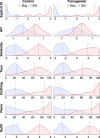Similarity in transgender and cisgender children's gender development
- PMID: 31740598
- PMCID: PMC6900519
- DOI: 10.1073/pnas.1909367116
Similarity in transgender and cisgender children's gender development
Abstract
Gender is one of the central categories organizing children's social world. Clear patterns of gender development have been well-documented among cisgender children (i.e., children who identify as a gender that is typically associated with their sex assigned at birth). We present a comprehensive study of gender development (e.g., gender identity and gender expression) in a cohort of 3- to 12-y-old transgender children (n = 317) who, in early childhood, are identifying and living as a gender different from their assigned sex. Four primary findings emerged. First, transgender children strongly identify as members of their current gender group and show gender-typed preferences and behaviors that are strongly associated with their current gender, not the gender typically associated with their sex assigned at birth. Second, transgender children's gender identity (i.e., the gender they feel they are) and gender-typed preferences generally did not differ from 2 comparison groups: cisgender siblings (n = 189) and cisgender controls (n = 316). Third, transgender and cisgender children's patterns of gender development showed coherence across measures. Finally, we observed minimal or no differences in gender identity or preferences as a function of how long transgender children had lived as their current gender. Our findings suggest that early sex assignment and parental rearing based on that sex assignment do not always define how a child identifies or expresses gender later.
Keywords: gender development; gender identity; transgender children.
Conflict of interest statement
The authors declare no competing interest.
Figures

References
-
- Astuti R., “‘It’s a boy! It’s a girl!’ Reflections on sex and gender in Madagascar and beyond” in Bodies and Persons: Comparative Perspectives from Africa and Melanesia, Lambek M., Strathern A., Eds. (Cambridge University Press, Cambridge, UK, 1998).
-
- Blackwood E., Sexuality and gender in Native American tribes: The case of cross-gender females. Signs J. Women Culture Soc. 10, 27–42 (1984).
-
- Callender C., et al. , The North American berdache. Curr. Anthropol. 24, 443–470 (1983).
-
- Mageo J. M., Male transvestism and cultural change in Samoa. Am. Ethnol. 19, 443–459 (1992).
-
- Vasey P. L., Bartlett N. H., What can the Samoan “Fa’afafine” teach us about the Western concept of gender identity disorder in childhood? Perspect. Biol. Med. 50, 481–490 (2007). - PubMed
Publication types
MeSH terms
Grants and funding
LinkOut - more resources
Full Text Sources

